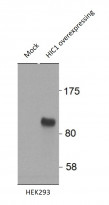ARG59691
anti-HIC1 antibody
anti-HIC1 antibody for Western blot and Human
Overview
| Product Description | Goat Polyclonal antibody recognizes HIC1 |
|---|---|
| Tested Reactivity | Hu |
| Predict Reactivity | Ms, Rat, Cow, Dog, Pig |
| Tested Application | WB |
| Host | Goat |
| Clonality | Polyclonal |
| Isotype | IgG |
| Target Name | HIC1 |
| Antigen Species | Human |
| Immunogen | Synthetic peptide around the internal region of Human HIC1. (NP_006488.2; NP_001091672.1, HLEGYPCPHLAYGEP) |
| Conjugation | Un-conjugated |
| Alternate Names | Zinc finger and BTB domain-containing protein 29; Hypermethylated in cancer 1 protein; ZNF901; ZBTB29; Hic-1; hic-1 |
Application Instructions
| Application Suggestion |
|
||||
|---|---|---|---|---|---|
| Application Note | WB: Recommend incubate at RT for 1h. * The dilutions indicate recommended starting dilutions and the optimal dilutions or concentrations should be determined by the scientist. |
Properties
| Form | Liquid |
|---|---|
| Purification | Ammonium sulphate precipitation followed by affinity purification with immunogen. |
| Buffer | Tris saline (pH 7.3), 0.02% Sodium azide and 0.5% BSA. |
| Preservative | 0.02% Sodium azide |
| Stabilizer | 0.5% BSA |
| Concentration | 0.5 mg/ml |
| Storage Instruction | For continuous use, store undiluted antibody at 2-8°C for up to a week. For long-term storage, aliquot and store at -20°C or below. Storage in frost free freezers is not recommended. Avoid repeated freeze/thaw cycles. Suggest spin the vial prior to opening. The antibody solution should be gently mixed before use. |
| Note | For laboratory research only, not for drug, diagnostic or other use. |
Bioinformation
| Database Links |
Swiss-port # Q14526 Human Hypermethylated in cancer 1 protein |
|---|---|
| Gene Symbol | HIC1 |
| Gene Full Name | hypermethylated in cancer 1 |
| Background | This gene functions as a growth regulatory and tumor repressor gene. Hypermethylation or deletion of the region of this gene have been associated with tumors and the contiguous-gene syndrome, Miller-Dieker syndrome. Alternative splicing of this gene results in multiple transcript variants. [provided by RefSeq, Sep 2010] |
| Function | Transcriptional repressor. Recognizes and binds to the consensus sequence '5-[CG]NG[CG]GGGCA[CA]CC-3'. May act as a tumor suppressor. May be involved in development of head, face, limbs and ventral body wall. Involved in down-regulation of SIRT1 and thereby is involved in regulation of p53/TP53-dependent apoptotic DNA-damage responses. The specific target gene promoter association seems to be depend on corepressors, such as CTBP1 or CTBP2 and MTA1. The regulation of SIRT1 transcription in response to nutrient deprivation seems to involve CTBP1. In cooperation with MTA1 (indicative for an association with the NuRD complex) represses transcription from CCND1/cyclin-D1 and CDKN1C/p57Kip2 specifically in quiescent cells. Involved in regulation of the Wnt signaling pathway probably by association with TCF7L2 and preventing TCF7L2 and CTNNB1 association with promoters of TCF-responsive genes. Seems to repress transcription from E2F1 and ATOH1 which involves ARID1A, indicative for the participation of a distinct SWI/SNF-type chromatin-remodeling complex. Probably represses transcription from ACKR3, FGFBP1 and EFNA1. [UniProt] |
| Cellular Localization | Nucleus. [UniProt] |
| Calculated MW | 77 kDa |
| PTM | Acetylated on several residues, including Lys-333. Lys-333 is deacetylated by SIRT1. Sumoylated on Lys-333 by a PIAS family member, which enhances interaction with MTA1, positively regulates transcriptional repression activity and is enhanced by HDAC4. [UniProt] |
Images (2) Click the Picture to Zoom In
-
ARG59691 anti-HIC1 antibody WB image
Western blot: HEK293 cells with mock transfection (left) or overexpressing Human HIC1 (right). The blots were stained with ARG59691 anti-HIC1 antibody at 0.5 µg/ml dilution and incubated at RT for 1 hour.
-
ARG59691 anti-HIC1 antibody WB image
Western blot: 35 µg of A549 and Jurkat cell lysates (in RIPA buffer) stained with ARG59691 anti-HIC1 antibody at 1 µg/ml dilution and incubated at RT for 1 hour.







